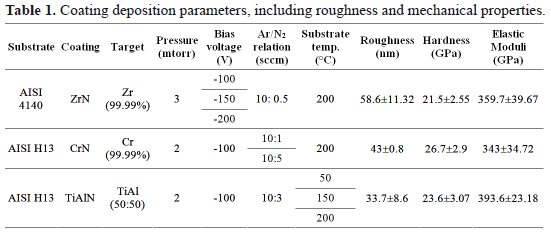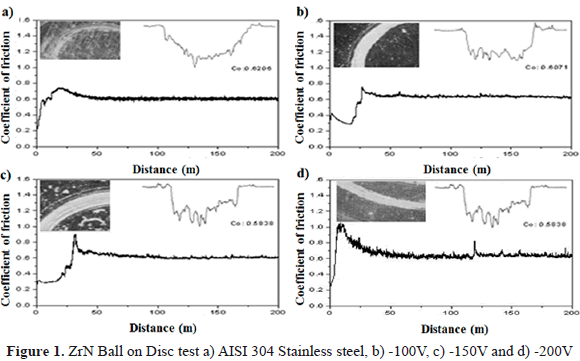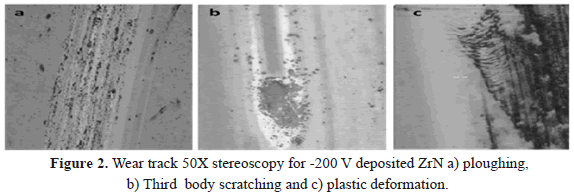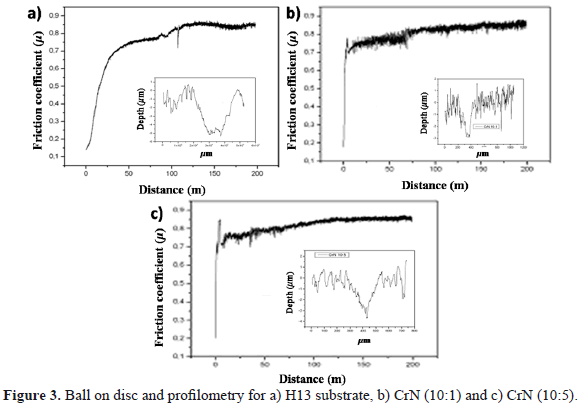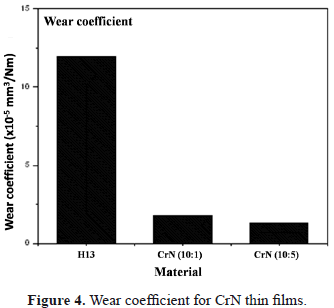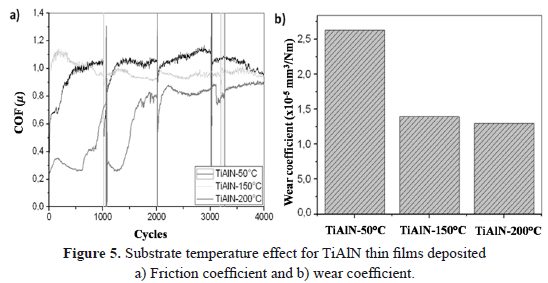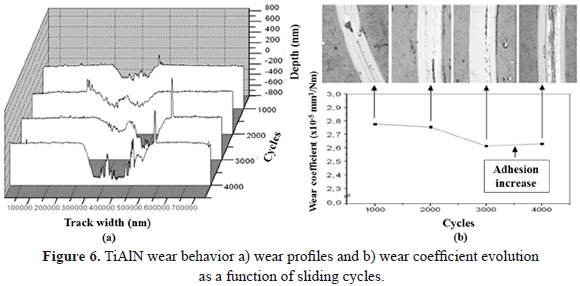Services on Demand
Journal
Article
Indicators
-
 Cited by SciELO
Cited by SciELO -
 Access statistics
Access statistics
Related links
-
 Cited by Google
Cited by Google -
 Similars in
SciELO
Similars in
SciELO -
 Similars in Google
Similars in Google
Share
DYNA
Print version ISSN 0012-7353
Dyna rev.fac.nac.minas vol.80 no.178 Medellín Mar./Apr. 2013
TRIBOLOGY OF ZrN, CrN AND TiAlN THIN FILMS DEPOSITED BY REACTIVE MAGNETRON SPUTTERING
TRIBOLOGÍA DE RECUBRIMIENTOS DE ZrN, CrN Y TiAlN OBTENIDOS POR MAGNETRON SPUTTERING REACTIVO
ALEXANDER RUDEN
MsC. Universidad Tecnológica de Pereira, Pereira-Colombia. arudenm@gmail.com
JUAN M. GONZÁLEZ
MsC. RDAI-Universidad del Valle, Cali - Colombia. juanmgonzalezc@gmail.com
JOHANS S. RESTREPO
MsC. RDAI-Universidad del Valle, Cali - Colombia. johansrestrepo@gmail.com
MICHELL F. CANO
Ing. RDAI-Universidad del Valle, Cali - Colombia. michaelfkn@gmail.com
FEDERICO SEQUEDA
PhD. RDAI-Universidad del Valle, Cali - Colombia. fsequeda@yahoo.com
Received for review February 1th, 2012, accepted December 14th, 2012, final version December, 20th, 2012
ABSTRACT: Friction and wear coefficient represent two important variables for hard coating selection in critical engineering applications such as cutting and material forming. To explain fully these variables, is necessary to understand different types of wear mechanisms that occur in coated surfaces. Zirconium nitride (ZrN), chromium nitride (CrN) and titanium aluminum nitride (TiAlN) coatings produced by reactive magnetron sputtering technique were evaluated. The tribological properties- coefficient of friction (COF) and wear coefficient were investigated using a ball on disc tribometer and profilometry. Bias polarization voltage showed an increase in plastic deformation and third body generation failures in the ZrN surface. Nitrogen flux increasing in CrN deposition, improves tribological behavior due to cubic phase segregation, enhancing superficial properties. Increasing substrate temperature during deposition of TiAlN improves superficial properties (roughness and porous density decrease), increases abrasion wear resistance and load capability of the coating.
KEYWORDS: Friction coefficient, Wear, Thin films.
RESUMEN: El coeficiente de fricción y el coeficiente de desgaste, representan dos variables importantes para la elección de recubrimientos duros en aplicaciones críticas de ingeniería tales como corte y conformado de materiales. Para explicar de manera profunda estas variables, es necesario conocer los diferentes tipos de desgaste que ocurren en estas superficies recubiertas. Se han evaluado recubrimientos de nitruro de circonio (ZrN), nitruro de cromo (CrN) y nitruro de titanio aluminio (TiAlN), producidos por la técnica magnetrón sputtering reactivo, determinando las propiedades tribológicas, midiendo coeficientes de fricción (COF) y desgaste, y mostrando un análisis de los mecanismos de desgaste presentes para cada recubrimiento durante el contacto tribológico en sistemas cerámicos. Se observó que el voltaje de polarización incrementa las fallas por deformación plástica y la generación de un tercer cuerpo en la superficie del ZrN. El aumento del flujo de nitrógeno en la deposición de CrN, mejora el comportamiento tribológico al segregar la fase cúbica del material, optimizando sus propiedades superficiales. Al incrementar la temperatura de deposición del TiAlN se mejora su calidad superficial (reducción de rugosidad y densidad de poros), reduciendo la abrasión y aumentando la capacidad de carga del compuesto.
PALABRAS CLAVE: Coeficiente de fricción, desgaste, películas delgadas.
1. INTRODUCTION
Nitride based thin films have a variety of applications in cutting and material forming principally in the growing polymer and metal-mechanical industries. This is due to their performance related to high hardness, elastic moduli, wear, corrosion resistance and thermal stability [1]. Broadly, nitrides are inorganic compounds, formed by nitrogen and other elements with lower electronegativity, except hydrogen and halogens. Nitrides composed by boron, titanium, zirconium, aluminum and silicon are hard and thermally stable, resulting in chemical attack resistant materials [2]; ZrN crystallizes in a face center cubic crystalline lattice; the base consists of a Zr and a N atom separated by half of the cube's principal diagonal with a covalent bond and permanent electric dipole [3]. ZrN is chemically stable, making it relevant for applications at high cutting speed. The material possesses high melting point (~2980°C) and the hardness obtained is similar to TiN, between 15.7 and 28.4 GPa [4, 5]. CrN thin films have increased applications due to high temperature functionality and high corrosion resistance, ideal for industrial applications in critical environments where wear is generated prematurely [6, 7]. Investigations performed on CrN thin films lead to applications in hot processing cutting tools, as final properties obtained such as hardness, wear and corrosion resistance increases compared to conventional coatings. CrN deposited films show high adhesion wear and pitting resistance, inhibiting metallic activation on the surface. Low temperature sputtered films have shown to decrease surface defects and dimension changes of parts when deposited on different kinds of substrates compared to other deposition techniques, presenting improvements in forming tools and dies working in high pressure conditions [8]. Compared to physical vapor deposition (PVD) deposited TiN and some chemical vapor deposition (CVD) coatings show enhanced superficial finish, lower coefficient of friction and thermal stability [9]. Titanium aluminum nitride thin films have been used in many applications due to chemical, thermal stability and high mechanical properties, presenting hardnesses as high as 30 GPa and low coefficients of friction. TiAlN coatings are suitability when oxidation resistance at higher temperature is required. Coatings deposited by PVD techniques have attracted attention in the recent past due to their excellent anti-oxidation properties and high hardnesses up to about 800°C and improved cutting performance especially in the higher cutting speed range as compared to TiN coatings [10]. In this paper a tribological study of different coatings is performed, including the influence of the mechanical properties that influence the wear mechanisms. For this reason, different thin films were synthesized varying deposition conditions: zirconium nitride (ZrN) deposited at different bias voltages, chromium nitride (CrN) deposited increasing nitrogen flow, and titanium aluminum nitride (TiAlN) varying deposition substrate temperature. Roughness, hardness and elastic moduli were also obtained, observing the wear coefficient, friction behavior and observing the wear track at different sliding distances for the Al2O3/film tribological pair.
2. EXPERIMENTAL DETAILS
Thin films were deposited using DC reactive magnetron sputtering in an AJA-ATC 1500 system. For monolayer production, polarization voltages, substrate temperatures and Ar/N2 gas relation were varied with the objective of obtaining improved tribological characteristics [11-14]. Table 1 shows deposition conditions used during sputtering process, obtained roughness, hardness and elastic moduli. Superficial properties and the resultant wear track were obtained using an Ambios XP-2 profilometer and observed by optical stereoscopy. Mechanical properties were obtained using nanoindentation in a Nanovea-Microphotonic equipment, using the Oliver and Pharr method [15]. Tribological characterization was performed in a CSEM tribometer according to the process parameter studied, for ZrN, CrN and TiAlN polarization voltage, reactive gas flow and substrate temperature were evaluated respectively. Ball on disk test conditions were constant for all deposited coatings (Table 2).
3. RESULTS AND DISCUTION
Zirconium nitride (ZrN): Figure 1 shows coefficient of friction results (COF), profilometry and 10X stereoscopy of the wear track as a function of polarization voltage (bias). Figure 1a shows AISI 4140 friction coefficient, with a mean COF of ~0.62. Differences between steel and alumina ball mechanical properties produces high abrasive wear, as seen by profilometry. Friction decreases when increasing the biasing (figures 1b, c and d). -200V bias deposited film presents anomalies in the initial stages of the ball on disk test due to plastically hardened third body formation, which are in the micrometer size.
After a rolling process these particles tend to weld to the exposed surface, creating new asperities. This process repeats until coating failure and COF stabilization of the steel/alumina ball tribological system. As a consequence, friction and superficial fatigue wear increases [16, 17]. Figure 2 shows 50X stereoscopy of the -200V bias deposited film. Ploughing wear (figure 2a), third body scratch (figure 2b), plastic deformation and superficial fatigue (figure 2c) are observed schematically and represents typical wear phenomena occurring in the ball on disk test for hard ceramic thin films such as ZrN.
Chromium nitride (CrN): Figure 3a shows the COF behavior and the H13 steel profilometry used to obtain wear rate. An equivalent procedure was performed on the CrN coatings deposited varying the Ar/N2 relation (figures 3b and c). COF decreases when nitrogen flux increases, a comparable tendency is also observed in the wear rate calculations in figure 4. The presence of a higher amount of N2 reactive gas induces the stable formation of the cubic phase, decreasing hexagonal and mixed phase formation, improving tribological behavior [18, 19].
Titanium Aluminum Nitride (TiAlN): Figure 5 shows the COF and wear coefficient behavior of the obtained thin films deposited at different substrate temperatures. The ball on disk test was stopped every 1000 cycles, in order to determine the wear evolution. The mean COF decreases with substrate temperature increase, due to lower roughness and higher density of the obtained films that increases superficial finish [20, 21, 22]. Asperity fracture and particle generation are also lower, producing a decrease in third body ploughing. It has been found that this behavior generates an improvement of the coating lifetime and explains wear reduction at higher substrate temperatures (figure 5b), increasing contact area and decreasing superficial fatigue and adhesion [21].
In order to understand the observed transitions in the wear mechanisms, figure 6 presents wear evolution as a function of sliding cycles for the 50°C TiAlN deposited film. Wear area in figure 6a, increases linearly in the initial stages due to abrasive wear and debris generation in the contact area. Transfer film generation is not observed, due to wear track widening up to 2000 cycles. The ball used was composed of Al2O3, the chemical stability of which avoids the formation of a transfer film on the coating surface. At the final stages of the sliding process, debris accumulation in the center of the wear track causes an abrasive-adhesive transition, those welded particles increase coating load capability. The process is repeated and new debris is generated due to the shear stress increasing. The wear coefficient stabilizes at the final stages due to predominant adhesion (figure 6b), changes in superficial features are minimum, except for debris accumulation in the center of the track and the formation of substrate oxides.
4. CONCLUSIONS
Tribological variables were studied according to deposition conditions for ZrN, CrN and TiAlN thin films (bias voltage, nitrogen flux and substrate temperature respectively). The study performed allowed the description of the tribological behavior of three different hard coatings and to determine the effect of the deposition parameters on friction and wear coefficient. ZrN shows three essential behaviors, typical of sputtered ceramic coatings in the ball on disk test: ploughing, third body scratch and superficial plastic deformation. The increase of the bias polarization voltage decreases coefficient of friction due to the increase in intrinsic stress and formation of third bodies. CrN thin films show high wear resistance, improved when using high nitrogen flow in the deposition process, due to phase segregation of the cubic crystalline structure. Increasing substrate temperature results in high density and low roughness, enhancing the tribological properties of TiAlN thin films. The coatings showed an increase in adhesion in the final stages of the ball on disc test which increased the load capability of the surface, generating a strong dependence of friction on superficial fatigue, increasing adhesion and reducing wear.
REFERENCES
[1] Hultman, L., Thermal stability of nitride films, Vacuum, 57, pp. 1-30, 2000. [ Links ]
[2] Mc-Gregor, D.R., Grown Optimization and Characterization of Reactively Sputtered Zirconium Nitride Thin Film for III-V Buffer Layer Applications. [PhD Thesis]. Raleigh, NC: North Carolina State University, 2002. [ Links ]
[3] Ruden, A., Restrepo, J. S., Muñoz, M., González, J. M., Neira, A. y Sequeda, F., Efecto del Flujo de Nitrógeno en la Estructura, Orientación Preferencial y Análisis DFT de ZrN Depositado Por Pulverización Magnetrónica Reactiva, Revista Latinoamericana de Metalurgia y Materiales, S1-3, pp. 1009-1013, 2009. [ Links ]
[4] Larijani, M.M., Tabrizi, N., Norouzian, Sh., Jafari, A., Lahouti, S., Haj Hosseini, H. and Afshari, N., Structural and mechanical properties of ZrN films prepared by ion beam sputtering with varying N2/Ar ratio and substrate temperature, Vacuum 81, pp. 550-555, 2006. [ Links ]
[5] Restrepo, E., Arango, P.J. y Casanova, S., Algunos conceptos sobre nitruro de titanio y el carburo de titanio, Revista Dyna, 76(157), pp. 213-224, 2009. [ Links ]
[6] Mo, J.L. and Zhu, M.H., Tribological oxidation behavior of PVD hard coatings, Tribology International, 42, pp. 1758-1764, 2009. [ Links ]
[7] Olaya, J., Marulanda, D. y Rodil, S., Recubrimientos de nitruros metálicos depositados con UBM: tecnología eficiente y ambientalmente limpia, Revista Dyna, 77(164), pp. 60-68, 2010. [ Links ]
[8] Barata, A., Cunha, L. and Moura, C., Characterization of Chromium Nitride Films Produced by PVD Techniques, Thin Solid Films 398-399, pp. 501-506, 2001. [ Links ]
[9] Hones, P., Sanjines, R. and Lévy, F., Characterization of sputter-deposited chromium nitride thin films for hard coatings, Surface and Coatings Technology, 94-95, 398-402, 1997. [ Links ]
[10] Poláková, H., Musil, J., Vlcek, J., Allaart, J. and Mitterer, C., Structure-hardness relations in sputtered Ti-Al-V-N films, Thin Solid Films, 444, pp. 189-198, 2003. [ Links ]
[11] Cuellar, J., Neira, A., Ruden, A. and Sequeda, F., Structural and Tribological Properties of Chromium Nitride - CrN Films on H-13 Tool Steels Produced by DC-Reactive Magnetron Sputtering, Rev. Society of Vacuum Coaters, 51, pp. 678- 683, 2008. [ Links ]
[12] Xu, J., Umehara, H. and Kojima. I., Effect of deposition parameters on composition, structures, density and topography of CrN films deposited by r.f. magnetron sputtering, Applied Surface Science, 201, pp. 208-218, 2002. [ Links ]
[13] Chou, W.J., Sun, C.H., Yu, G.P. and Huang, J.H., Optimization of the deposition process of ZrN and TiN thin films on Si(100) using design of experiment method. Materials Chemistry and Physics, 82, pp. 228-236, 2003. [ Links ]
[14] Chakrabarti, K., Jeong, J.J., Hwang, S.K., Yoo, Y.C. and Lee, C.M., Effects of nitrogen flow rates on the growth morphology of TiAlN films prepared by an rf-reactive sputtering technique, Thin Solid Films, 406, pp. 159-163, 2002. [ Links ]
[15] Oliver, W.C. and Pharr, G.M., Instrumented indentation: Advances in understanding and refinements to methodology, Journal of Materials Research, 19-1, pp. 3-20, 2004. [ Links ]
[16] Muñoz, M., Neira, A., Ruden, A. and Sequeda, F., Effect of Process Variable on the Mechanical and Tribological Properties of DC Reactive Magnetron Sputtering ZrN Films Deposited on AlSl D3 and 4140 Steel, Rev. Society of Vacuum Coaters, 51, pp. 673-677, 2008. [ Links ]
[17] Augera, M.A., Araiza, J.J., Falcony, C., Sánchez, O. and Albella, J.M., Hardness and tribology measurements on ZrN coatings deposited by reactive sputtering technique, Vacuum, 81, pp. 1462-1465, 2007. [ Links ]
[18] Cuellar, J., Sequeda, F., Ruden, A. y Restrepo, J., Análisis estructural, químico y tribológico de recubrimientos de CrN depositados sobre aceros de uso industrial con la técnica de pulverización catódica reactiva, El Hombre y la Maquina, 32, pp. 132- 141, 2009. [ Links ]
[19] Navingek, B., Panjan, P. and Cvelbar, A., Characterization of low temperature CrN and TiN (PVD) hard coatings, Surface and Coatings Technology, 74-75, pp. 155-161, 1995. [ Links ]
[20] González, J. M., Ruden, A., Neira, A., Sequeda, F. and Leroux, P., Influence of Substrate Temperature on Structure and Tribological Properties of TiAlNV, Rev. Society of Vacuum Coaters, 51, pp. 666 - 672, 2008. [ Links ]
[21] Grzesik, W., Zalisz, Z., Krol, S., Nieslony, P., Investigations on friction and wear mechanisms of the PVD-TiAlN coated carbide in dry sliding against steels and cast iron, Wear, 261, pp. 1191-1200, 2006. [ Links ]
[22] Cano, M.F., Restrepo, J.S., Ruden, A., González, J.M. and Sequeda, F., The Effect of Substrate Temperatures on Tribological Behavior of Ti-Al-N Coating Deposited by Magnetron Sputtering, Rev. Society of Vacuum Coaters, 52, pp. 37-43, 2009. [ Links ]













